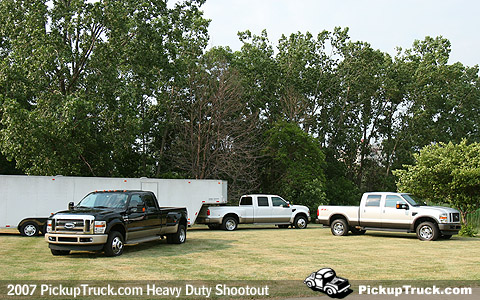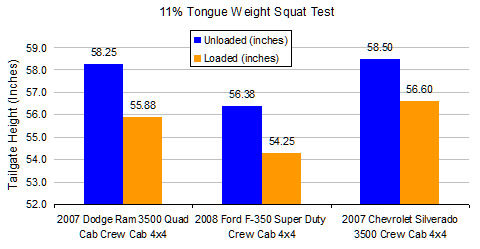2008 Ford F-250 Super Duty FX4 Crew Cab 4x4 The F-250 we drove had the largest, most powerful gas engine we tested. It also had the lowest rear axle gearing, 4.30. This made for an exceptional towing rig but compromised performance when the truck was unloaded. It had around 80 ft-lbs more torque than either of the V8s in the Sierra or Ram – another towing advantage. Even though its engine had two more cylinders than the GMC or Dodge 2500s, the item we found most interesting about the F-250 was that it weighed in over 1,000-pounds heavier than its cross-town competitors. We actually had the truck weighed twice to make sure it wasn’t a mistake. Ford attributes the weight difference to stronger construction and heavier parts for improved longevity. Another interesting point, the Triton F-250 uses the same 5-speed TorqShift transmission as the Power Stroke equipped F-350.
All the Ford trucks had high-end trim packages, so the interior on this truck was a few notches above the Sierra and Ram. Seating surfaces were leather with power driver and passenger captains chairs. Kudos to Ford for protectively covering the beds side tops on all Super Dutys with plastic lining, so they don’t get gouged or dinged loading and unloading the cargo box. We didn’t feel guilty balancing heavy items on these surfaces. Ford made major revisions to the Super Duty for the 2008 model year. It’s got new looks on the outside and underneath the front boxed portion of the frame has been widened and strengthened to improve safety and to accommodate the extra emissions and cooling equipment. The frame’s back end has also been modified to handle 8-inch longer leaf springs, which made for better ride and handling towing trailers than earlier Super Dutys. This truck, and the F-350, drove better when loaded. 2008 Ford F-350 King Ranch Super Duty Crew Cab 4x4 After the warranty and reliability challenges caused by the old 6.0-liter Power Stroke diesel, Ford’s got a lot riding on the success of the new 6.4-liter PSD. At the core of this diesel V8, it’s a heavily updated version of the 6.0-liter, with more power and designed around meeting the new emissions regulations. The larger displacement is one approach used to help knock down NOX levels through cooler engine temperatures. There are other heat management upgrades to keep temps down, like a 33% larger radiator, 50% larger water pump, and a diesel fuel cooler. The engine uses dual sequential turbos to help get the truck moving during takeoff. Ford offers what it calls ‘traction control’ for the F-350. We’re not sure we agree with the terminology here, because the F-350’s traction control only reduces throttle when it senses wheel slip. There’s no assistance from the ABS or steering systems, like other traction control systems use.
Our F-350 had the King Ranch interior and exterior treatment. Heavy duty pickup interiors don’t get any nicer than the King Ranch leather. The combination of materials, colors, and textures used throughout the cabin are first class. Ford has also given the F-350 the largest and most capable mirrors in its class. Built by Schefenacker, in Australia, the double-armed tow and spotter mirrors could be extended outward up to 2-3/4-inches or folded inward electronically with the touch of a button. The F-350 also came with Ford’s optional built in Tailgate Assist setup – which neatly integrates a pullout step and handle into the truck’s liftgate to make hopping up into the bed very easy. |
|
2008 Ford F-450 Lariat Super Duty Crew Cab 4x4 – Big Dog Daddy If you’re a manufacturer, how do you really know if your pickup has gained acceptance with true truckers? When it has songs written about it by a country music star, like Toby Keith. Keith has gone even farther and named his entire summer tour after the ‘Big Dog Daddy’ F-450 – which is capable of towing up to 24,500-pounds. When we put this year’s shootout together we asked Ford to prove the F-450’s capabilities. They came through by delivering the truck with a 4.88 rear axle hitched to a 20,000-pound three axle fifth wheel trailer. With an estimated curb weight of approximately 8,850-pounds, we were driving an almost 30,000-pound rig around metro Detroit! The F-450 had the same 6.4-liter PSD as the F-350, but due to the truck’s very low final drive ratio, power was detuned to 325-horsepower and 600 lbs-ft of torque. This is a new power management approach from Ford that we believe is used to increase engine life. If we had been loaned an F-450 with a taller 4.30 rear axle, PSD output would have been equal to the F-350’s.
Before the 2008 model year, Ford used to hold PSD power ratings the same across all its Super Duty pickups, including the F-450 and F-550 chassis cab models. GM follows a similar limited-output approach in its diesel 4500/5500 medium duty trucks, by detuning the Duramax’s power ratings below those found in its three-quarter and one-ton pickups. We’d never dream of running this truck as an unloaded daily driver. It would be like buying a $1000 espresso machine to make decaf coffee. You just don’t do it. Look for Ford to offer the F-450’s front radius-arm suspension as an option on the F-350 by late summer. The advantage of this setup is greater front load bearing capacity and improved turning maneuverability. You’ll be able to recognize it by the arched fender flares over the front wheels, needed to cover the wider track of the F-450’s front axle. The Tests Think we’re done with our shootout? We haven’t even gotten warmed up. Here’s the results of our first exam. Squat Test For our squat test we took one of the 10,500-pound trailers and rotated hooking each of the three-quarter and one-ton trucks up to it. We wanted to measure how much the rear suspension of each pickup would compress under load. To ensure we were only loading the rear suspension, we didn't use weight distributing equipment. The trailer had an 11% (1,075-pound) tongue weight - the downward force applied by a trailer's own weight and cargo on the hitch ball. Three-Quarter-Ton Pickups
One-Ton Pickups
Looks like Ford's newly lengthened leaf springs (increased by 8-inches over 2007) didn't dramatically impact the levelness of the Super Duty's suspension under load, while still helping to moderately improve ride comfort. Quarter-Mile Unloaded and Loaded Test Here's Part 2 of the PickupTruck.com Heavy Duty Shootout, with the results of our 1/4-miles runs. |







